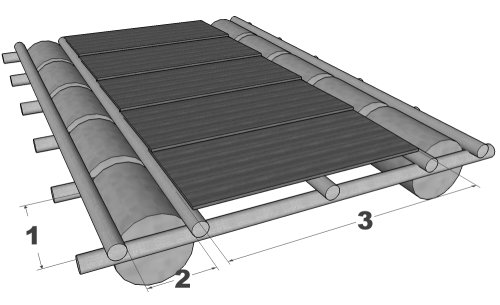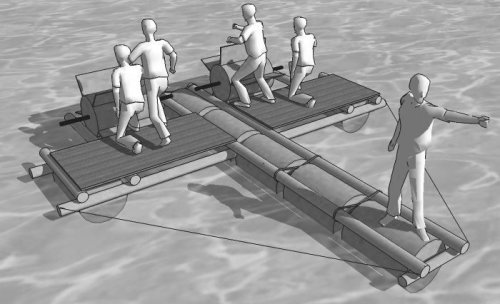
As part of the lead-up to Kontiki, I'll be posting a few tips about building rafts. View all of my raft tips and designs here.
If you are taking a raft out on the water and you are untethered (ie. not tied to the shore) you will need one, preferably two good anchors. Anchor ropes should be long enough (3 times the depth of the water is a good rule of thumb) and in good condition, and tied securely to both the anchor and the raft. An anchor bend is designed for this purpose.
The drawing above illustrates a piece of advice that we discovered the hard way: when you place your anchors, make sure that the mouth of your tent point away from your anchorage points. Here's why: once you cast anchor, if the wind blows, your raft will turn to face anchors-first into the wind. If there is precipitation (superstition prevents me from saying the R-word in connection with Kontiki) then it will come flowing straight into your tent if the door is facing the same way as the anchors. Our troop discovered this during a particularly powerful
 As for the actual anchors- if you can get the real thing, then great: a folding grapnel anchor or two do a really good job here. If you're not a Sea Scout, then don't worry about such things: click on the image on the left for instructions for making a 'Kontiki pattern' anchor. This drawing is courtesy of the Gauteng Kontiki page, where it was hosted until recently, and I'm posting it here for anyone who needs a solid, easy-to-make raft anchor.
As for the actual anchors- if you can get the real thing, then great: a folding grapnel anchor or two do a really good job here. If you're not a Sea Scout, then don't worry about such things: click on the image on the left for instructions for making a 'Kontiki pattern' anchor. This drawing is courtesy of the Gauteng Kontiki page, where it was hosted until recently, and I'm posting it here for anyone who needs a solid, easy-to-make raft anchor. Next I'll be looking at how you can move your raft around: oars, paddlewheels, punting and sails.




